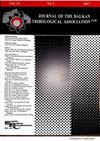用干馏法减少碳氢混合物精馏时的边界膜厚度
Q3 Engineering
引用次数: 1
摘要
在碳氢化合物混合物的蒸馏中使用水蒸气会产生不良后果。对油气凝析油原料一次蒸馏过程的透视方法进行了验证。确定了替代蒸汽剂精馏过程的质量变化特性,并与传统蒸汽剂的各项指标进行了比较。本文章由计算机程序翻译,如有差异,请以英文原文为准。
REDUCTION OF THE THICKNESS OF THE BOUNDARY FILM AT RECTIFICATION OF HYDRO CARBONIC MIXES WITH APPLICATION OF DRY DISTILLATION
The use of water steam at distillation of hydrocarbon mixes results in negative consequences. There are proved the perspective method of process of primary distillation oil and gas condensate raw materials. There are defined mass-change characteristics of process of rectification at use of alternative steaming agents and their comparisons with indicators of traditionally applied steaming agent are done.
求助全文
通过发布文献求助,成功后即可免费获取论文全文。
去求助
来源期刊
CiteScore
1.10
自引率
0.00%
发文量
4
审稿时长
3.0 months
期刊介绍:
The decision for editing and printing of the current journal was taken on Balkantrib''93, Sofia, October, 1993 during the Round Table discussion of the representatives of the Balkan countries: Bulgaria. Greece, Former Yugoslavian Republic of Macedonia, Romania, Turkey and Yugoslavia. The Journal of the Balkan Tribological Assosiation is dedicated to the fundamental and technological research of the third principle in nature - the contacts. The journal will act as international focus for contacts between the specialists working in fundamental and practical areas of tribology. The main topics and examples of the scientific areas of interest to the Journal are:
overall tribology;
tribotechnics and tribomechanics; friction, lubrication, abrasive wear, boundary lubrication, adhesion, cavitation, corrosion, computer simulation, vibration phenomena, mechanical contacts in gaseous, liquid and solid phase, technological tribological processes, coatings, etc.;
tribochemistry - defects in solid bodies, tribochemical emissions, triboluminescence, tribochemiluminescence, technological tribochemistry; composite materials, polymeric materials in mechanics and tribology; special materials in military and space technologies, etc.;
kinetics, thermodynamics and mechanism of tribochemical processes;
biotribology - biological tribology, tribophysiotherapy, tribological wear, biological tribotechnology, etc.;
lubrication - solid, semi-liquid lubricants, additives for oils and lubricants, surface phenomena. wear in the presence of lubricants; lubricity of fuels;
ecological tribology; the role of tribology in the sustainable development of technology:
management and organisation of the production; machinery breakdown; oil monitoring;
European legislation in the field of tribotechnics and lubricating oils;
educational problems in tribology, lubricating oils and fuels.

 求助内容:
求助内容: 应助结果提醒方式:
应助结果提醒方式:


